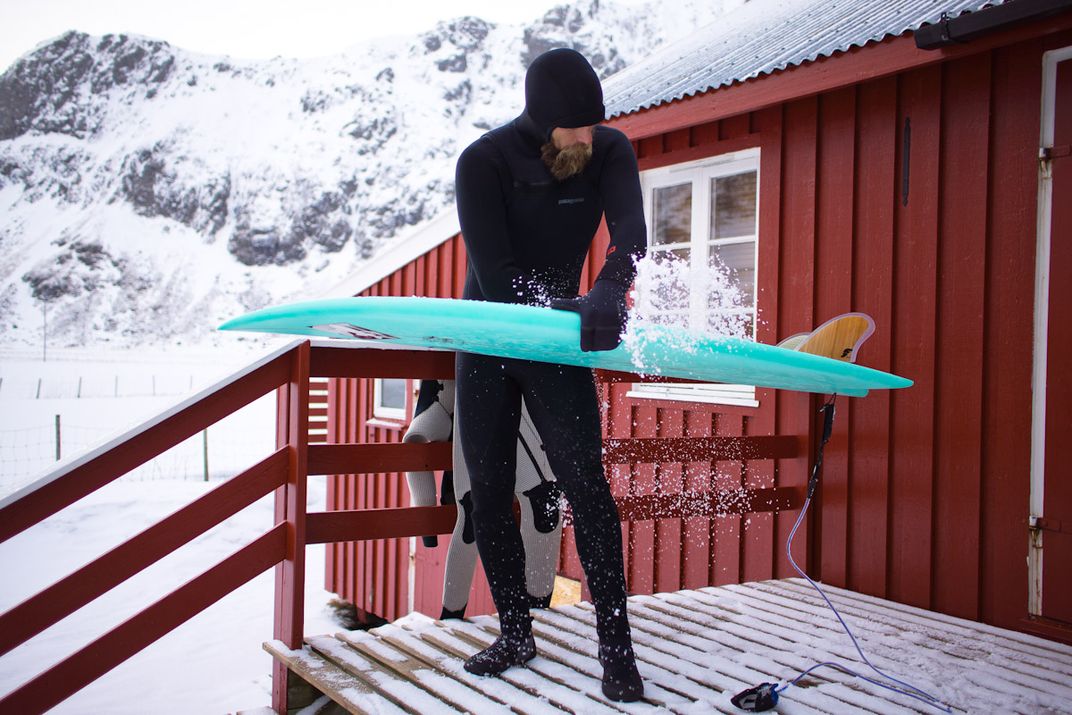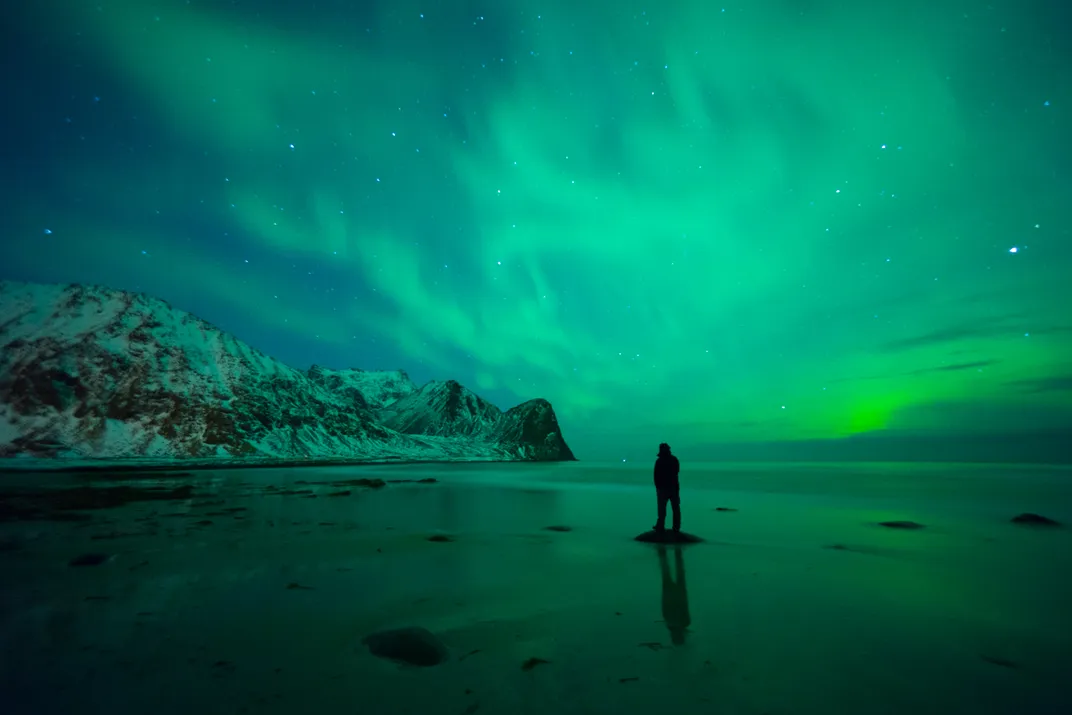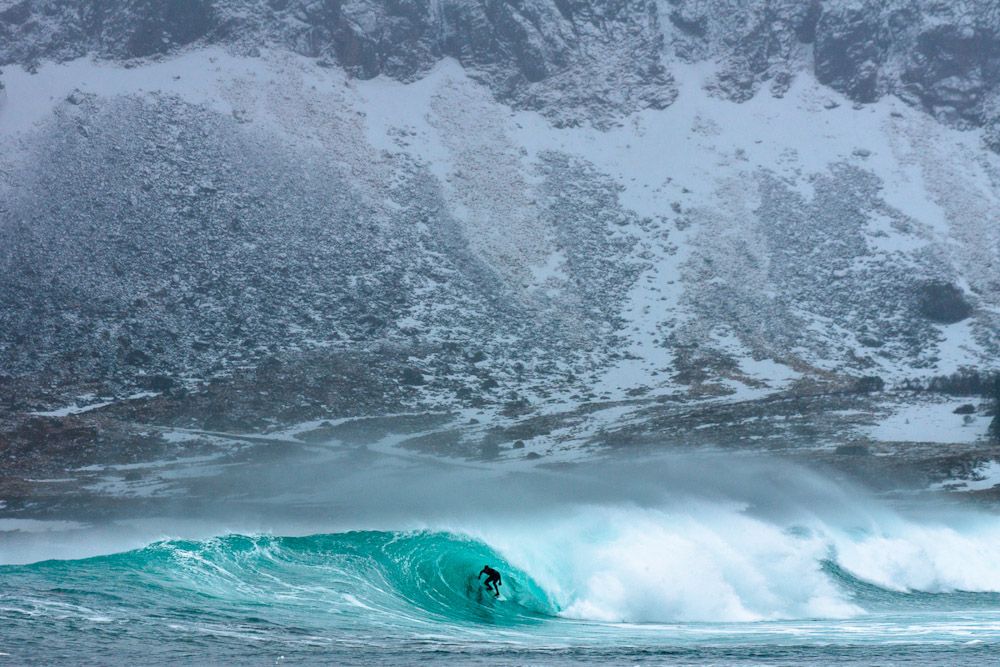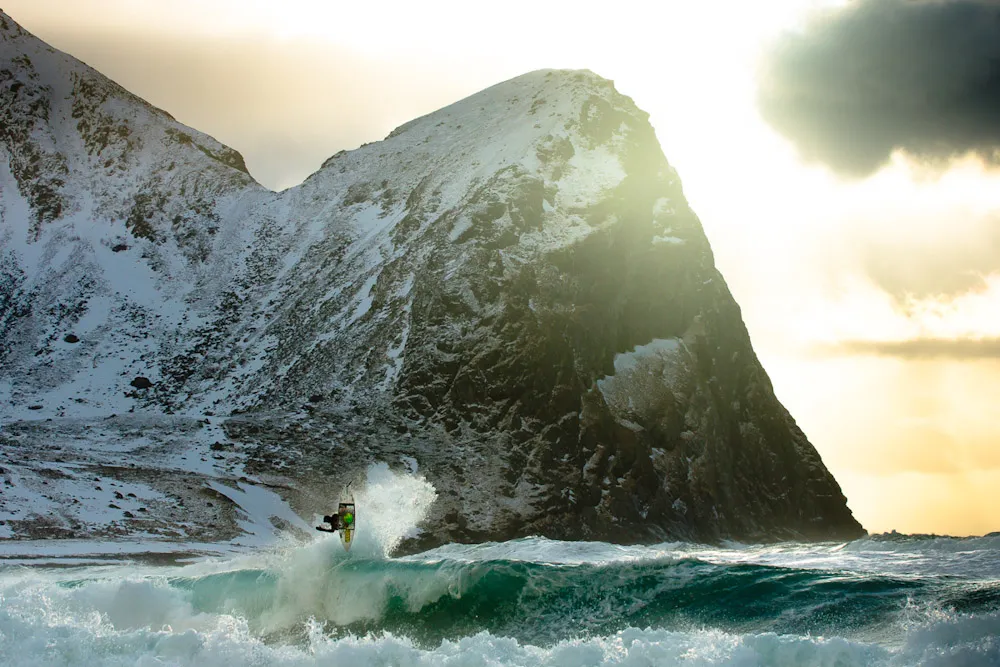Meet the Insane Surfers Who Travel to the Arctic Ocean to Catch a Wave
Photographer Chris Burkard takes pleasure in working through the misery of the ice-cold waters of Norway
Southern California, Hawaii and Australia are all legendary locales for some of the best surfing in the world, and the pristine beaches and palm trees only add to the allure. But for Chris Burkard and surfers Patrick Millin, Brett Barley and Chadd Konig, the more exciting waves can be found among the snow-capped mountains, jagged blue ice crystals and the Northern Lights of the Arctic.
This March, a two-man production team followed award-winning surf photographer Chris Burkard and three warm-blooded surfers to the northern 68th parallel, at Unstad Beach in Norway. The result was a new SmugMug Films short documentary, Arctic Swell: Surfing the Ends of the Earth.
The California-based Burkard, the senior staff photographer at Surfer magazine, relishes being able to travel great distances to photograph the most interesting surf locales. He is adept at pairing surfing action against dramatic landscapes. His recent book, the aptly-titled “Distant Shores: Surfing at the Ends of the Earth,” features surf photography from across five continents.
“I want people to drift away when they look at my images,” says Burkard in the film. “I want them to feel like it’s taken them so far from where they are at that moment that they’re immersed in that feeling,”
I caught up with Chris below via e-mail to discuss what makes surfers tackle the Arctic and just how it feels to get in that frigid water.
How did you first learn about extreme cold water surfing?
Growing up around the ocean on the Central Coast of California, where the water can dip under 50 degrees in the winter, helped mold me into a bit of a cold water advocate. The first cold water surf trip I took was to Canada. Surfing amongst lush forests and snow-capped peaks was a refreshing environment and change from your typical palm trees and white sand beaches....What I love about the Arctic is the challenge that comes in the form of weather, logistics, and navigating your way across a foreign land. I find that amidst the harsh conditions there are glimpses of beauty and finding them makes it all worthwhile.
And what intrigued you about the Arctic Swell project?
I've been sharing images from my travels to the Arctic for six or so years but there hadn't been much video to supplement the moments that go into these trips. This trip presented itself as a great opportunity to show behind the scenes of what goes into an Arctic surf trip for myself and for the athletes. I was stoked to be able to share some moments from a place as unique as Norway.
Why do you think surfers are drawn to the idea of surfing in the Arctic region?
There's always this idea for any athlete of progression and pushing the realm of possibilities for themselves. Surfing presents some insane challenges in the form of freezing water (40 degrees), snowstorms and other brutal weather. There's an entirely different wonder and excitement with these locations that draws us to these extreme regions.
You don’t just stand on the shoreline while you’re shooting–you often get in, too. So how cold is it in there, really?
Anybody who enters these waters will tell you that it's a crazy sensation. Water touching your exposed skin can literally burn like fire. Your fingers and face swell up and you can feel your body shutting down. As you duck under waves you get the worst ice cream headache you've ever had. The conditions are certainly adverse.
So what do you and the other surfers do to keep warm?
We rely a lot on "warm" wetsuits, made of thick rubber (5-7mm). We wear thick gloves and booties, and it's crucial to make sure you're warm before you actually enter the water because once you're out in the ocean you can't warm back up. Other than that it's beneficial to have a strong will and mindset to withstand the cold.
Any tricks to keep your cameras from freezing up?
It's not necessarily the cold that is going to cause your camera problems but the other weather elements. To avoid fogging, I use silica packets in my camera bag. I like to keep a rain jacket or camera cover handy as well as plenty of lens wipes for moisture. It's also important to keep batteries warm because battery life is noticeably shorter in [cold] places like Norway.
You do an amazing job of giving the landscape its due, pairing surfing action shots with beautiful natural formations. What kind of preparation do you do for your shoots?
I always highlight a wave in context to its surroundings; pulled-back shots really give the viewer an idea of the region. In a place with a unique environment like Norway, I felt it was important to incorporate the land into the surfing image. In preparation for these types of shots I definitely am mindful not just of the surfer but what else I can incorporate into my shot whether it's a landmark, headland or some unique foreground.
You’ve photographed surfing all over the world, as seen in your recent book–what was the best thing about shooting in the Arctic?
I love the challenge of shooting in the Arctic and the stories that come from these remote corners of the world. My favorite part about shooting in the Arctic is the backdrops and setups you get on those cold-water trips that are like nothing you've ever seen. When you’re shooting in the water in a place like Norway, it’s not about trying to stay comfortable, but trying to be smart and stay alive. It’s really a battle against the elements. But I think that’s sort of what draws me to shooting in really different, and often times, frigid locations.
And the worst?
Shooting in the water can be dangerous and brutal. I remember feeling like my vital organs were shutting down and my fingers began to numb, even with gloves. There were times when I couldn't use my fingers to touch the camera shutter button so I had to take pictures using my chin. At times it was hell.
So what’s the next challenge on your list? Antarctica, perhaps?
I'm eager to return to these regions that I love, like Norway and Iceland, but I'm also setting my sets on new and foreign lands. Antarctica has always been in the back of mind. It's the mecca for cold exploration, but logistically it's very difficult. I'd love to go to the Alps and to the Svalbard Islands of Norway, but I'm excited to go anywhere remote and desolate. Those are the places that speak to me.
/https://tf-cmsv2-smithsonianmag-media.s3.amazonaws.com/accounts/headshot/Jeff-Campagna-240.jpg)
/https://tf-cmsv2-smithsonianmag-media.s3.amazonaws.com/filer/ab/ea/abeacf32-a228-4c2e-9864-d7e47a5014e4/140321_burkard_128433.jpg)
/https://tf-cmsv2-smithsonianmag-media.s3.amazonaws.com/filer/f9/56/f9564f3a-97f1-4500-b142-86048260f66a/140321_burkard_129127.jpg)
/https://tf-cmsv2-smithsonianmag-media.s3.amazonaws.com/filer/45/61/4561063e-a2e2-4c24-a721-7a14bf18de0a/120529_burkard_136257.jpg)

/https://tf-cmsv2-smithsonianmag-media.s3.amazonaws.com/filer/3a/c4/3ac43888-a578-4097-8b49-b664914a36a8/120313_burkard_04828.jpg)
/https://tf-cmsv2-smithsonianmag-media.s3.amazonaws.com/filer/3a/23/3a2355a9-69ce-4290-b824-3ec1ab8a5e29/140327_burkard_136013.jpg)


/https://tf-cmsv2-smithsonianmag-media.s3.amazonaws.com/filer/2f/ec/2fecadf2-d24f-4f54-a18c-26b63179b157/120313_burkard_09220.jpeg)
/https://tf-cmsv2-smithsonianmag-media.s3.amazonaws.com/filer/5e/ba/5eba213f-3bda-4bba-822b-7b1fb04f21f2/chris_burkard.jpg)

/https://tf-cmsv2-smithsonianmag-media.s3.amazonaws.com/accounts/headshot/Jeff-Campagna-240.jpg)